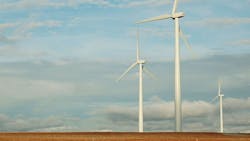Southern Power’s 118-MW Glass Sands Wind project now operational
The Glass Sands Wind Facility in Murray County, Oklahoma, is now operational.
Wholesale energy firm Southern Power, a subsidiary of Atlanta-based utility giant Southern Co., announced the start for the 118-MW Glass Sands farm. The facility consists of 28 wind turbines manufactured by Vestas.
The electricity and renewable energy credits from the facility will be sold under a power purchase agreement with Amazon.
“We are pleased to see Glass Sands Wind Facility achieve commercial operation as this facility represents an incredible accomplishment for our employees and partners involved with the project,” said Southern Power President Bill Grantham. “This facility showcases our commitment to the development of wind energy and is an excellent addition to our growing renewable fleet.”
Southern Power acquired Glass Sands Wind Facility from Steelhead Americas, Vestas’ development arm in North America, in December 2020. M. A. Mortenson Company served as the constructor of the site, which created more than 250 jobs at peak construction.
The Glass Sands Wind Facility is Southern Power’s 15th wind facility and its fifth wind facility in Oklahoma. With the addition of this facility, Southern Power’s wind portfolio has expanded to more than 2,534 MW of wind generation. Its renewable fleet is now 4,930 MW, comprising 43 solar and wind facilities.
About the Author
EnergyTech Staff
Rod Walton is senior editor for EnergyTech.com. He has spent 17 years covering the energy industry as a newspaper and trade journalist.
Walton formerly was energy writer and business editor at the Tulsa World. Later, he spent six years covering the electricity power sector for Pennwell and Clarion Events. He joined Endeavor and EnergyTech in November 2021.
He can be reached at [email protected].
EnergyTech is focused on the mission critical and large-scale energy users and their sustainability and resiliency goals. These include the commercial and industrial sectors, as well as the military, universities, data centers and microgrids.
Many large-scale energy users such as Fortune 500 companies, and mission-critical users such as military bases, universities, healthcare facilities, public safety and data centers, shifting their energy priorities to reach net-zero carbon goals within the coming decades. These include plans for renewable energy power purchase agreements, but also on-site resiliency projects such as microgrids, combined heat and power, rooftop solar, energy storage, digitalization and building efficiency upgrades.
